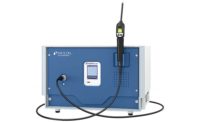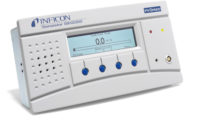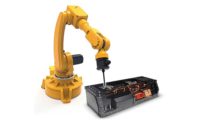There is a big difference between squeaky products and leaky products, especially in manufacturing. The former simply require a little grease, whereas the latter cause a lot of grief—to both the manufacturer and end-user.
Appliance manufacturers, especially, know the importance of making sure their products are leak-free from day one. In some cases, such as a gas stove, a leak could be deadly.
The leak testing process performed on assembly lines is often time consuming; ranging from a few seconds for small items up to more than a minute for larger ones. Fortunately, this type of testing is increasingly being automated, especially on high-volume production lines.
BSH Hausgeräte GmbH (BSH Home Appliances Corp.) is one of the largest home appliance manufacturers in Europe. Recently, it implemented automated leak testing of each refrigerator made at the company’s plant in Esquíroz, Spain.
The automated system provided by Micropsi Industries consists of an Inficon E3000 multi-gas leak detector connected to a Universal Robots cobot arm. The detector uses an in-house-designed sniffer probe, and MIRAI controls the arm using artificial intelligence (AI) and vision cameras.
Leak testing involves running the probe along metal pipes and compressors at the back of the fridge to check for leaking coolant at the solder joints. Because the back of each model is unique in terms of position, color, shape and amount of soldering points, the process was performed manually until early in 2021.
"MIRAI’s machine learning technology [helped us] solve a challenge we could not solve with standard automation technology," notes Javier Chasco Echeverria, Industry 4.0 engineer at BSH. "All cycle time, accuracy and key performance indicators have been reached, improving our productivity and quality."
MIRAI helps a robot perceive its workspace and correct its movement while performing a task. Echeverria says the benefits of using MIRAI at BSH include reliable identification of all inspected solder joints; and real-time response and millimeter-level precision placement of the probe regardless of joint position, shape or color.
Every appliance leaks somewhat over time, and often at the interface where gas, refrigerant or water enters the appliance. The challenge for manufacturers is finding the best equipment to perform the right tests that ensure the leak level never exceeds performance specifications and environmental law limits—be it on a simple coffeemaker or a top-of-the-line refrigerator or washing machine.
Most Common Methods
Appliance manufacturers rely on several tried-and-true methods to leak test their products. Most of them—mass flow, pressure decay, differential pressure and tracer sniffing—involve pressurizing the product, isolating it from the pressure source and carefully observing to detect if any pressure decreases or gas escapes. With vacuum decay, in contrast, the product is evacuated and then monitored to see if gas flows into it.
Pressure decay testing effectively detects leak paths by moving air from a high-pressure area to a low-pressure one. Any reduction in pressure over time is displayed as a pressure change rate. Or, the volumetric leakage rate can be calculated from the pressure reduction.
In the differential pressure leak test, a reference volume is pressurized along with the test part. A transducer reads any pressure differential that develops over time between the leaking part and the nonleaking reference.
According to test-equipment suppliers, differential pressure testing is well-suited to applications requiring relatively high test pressures. In addition, it typically provides higher sensitivity, more repeatability and faster test times than pressure decay testing.
Similar to pressure decay, mass flow testing is based on the ideal gas law, where volume and temperature changes affect the pressure in the part as much as the loss of air. Many engineers prefer mass flow testing because of the advanced capabilities of today’s measurement instruments. These instruments provide fast response times and accurate leak rates for all types and sizes of components and finished appliances.
Tracer gas sniff leak testing is recommended for critical components with low leak rate requirements. The advantage of this testing is it is unaffected by temperature or pressure changes occurring inside the part. However, the test’s sensitivity can be affected by uncontrolled atmospheric trace gas that creates background noise.
The simplest tracer gas testing method involves using a handheld sniffer to identify leak location after air is evacuated from the part and replaced with a tracer gas (e.g., helium or forming gas) under pressure. A more controlled test methodology is trace gas accumulation, where a part is placed in a chamber and gas is accumulated in a fixed volume. The change in gas concentration within the chamber is then measured.
Vacuum leak testing tends to provide better repeatability because it is less sensitive to environmental variables created by temperature changes. A vacuum leak detector often requires less time to reach a stable test pressure, is less susceptible to potential instability of tested parts, and offers shorter cycle times than tests in many pressure decay applications.
Cosmo Solutions Technology Inc. has made leak-testing equipment since 1970, for manufacturers of appliances like washers, dryers, refrigerators, freezers, hot water tanks, and gas ranges and grills. The company specializes in equipment for differential pressure decay, mass flow and laminar (not turbulent) flow testing.
Rich Johnson, service manager and sales and application engineer at Cosmo, says that laminar flow is a secondary test for appliance manufacturers, used only to measure the flow rate of water, not water leakage. The company’s main air leak tester, the LS-R902, performs differential pressure decay testing with high sensitivity. It is used to ensure zero water leakage in ice makers, water dispensers, washing machines and steam clean dryers.
“Manufacturers regularly use the LS-R902 to test appliance subcomponents," notes Johnson. “Examples include a range top valve/burner, oven valve/burner system, gas regulators and gas line connections. As for fully assembled appliances, the tester is used to check for leaks in line connections for natural gas, propane, and water.”
Introduced in 2018, the LS-R902 features a color LCD touchscreen filled with intuitive and user-friendly icons. Engineers can select any of six measurements (simple, standard, waveform, etc.) for an application. A USB driver lets them download and upload testing recipes as needed. The tester also offers Ethernet capability.
“The process of leak testing appliances is not any more challenging for manufacturers than testing other products, per se, but their focus is to always perform high-quality testing while maintaining assembly line throughout,” explains Jacques Hoffmann, president of InterTech Development Co. “Customers use our pressure decay and mass flow testers at the functional level for appliances like tankless water heaters, and water filters and valves.”
Hoffmann says that helium and tracer gas testing tends to be used for leaks from 10-1 to 10-4 millibar liters per second (mbar l/s) or standard cubic centimeters per minute (scc/m). Pneumatic leak testing is more suitable for leaks from 10-5 to 10-7 scc/m.
The M1075 leak tester from InterTech is equipped with a small mass-flow sensor that can speed up testing by as much as 30 percent. Hoffmann says this is because the sensor has a much faster reaction and recovery time back to zero than larger sensors, and it requires a much lower pressure drop across the sensor to obtain a measurable flow. FastFill and Ex-Heat features speed-up testing of large volumes.
The tester stores 40 million test results and 99 test programs, and it can be operated as a stand-alone instrument or interfaced with a PLC or PC. Other standard features include a bar code scanner interface, simplified calibration, Ethernet/IP connectivity, real-time test cycle displays, and a touchscreen control panel.
Components in Focus
Key appliance components include coils, compressors, digital controls, evaporators, filters, motors, pumps, sensors and switches. Most are leak tested individually, although some also get retested during the final testing of an assembled appliance. In general, individual testing makes it easier to reach critical joints and connections within the components.
Tier 1 appliance suppliers often use equipment from Pfeiffer Vacuum Inc. to leak test many of the components used in refrigeration systems, says John McLaren, senior product applications manager for leak detection at Pfeiffer. Motors and pumps may be tested as well, but only if they’re enclosed within the appliance.
Equipment from Zeltwanger Leak Testing & Automation is used for pressure decay, differential pressure and mass flow testing of components using air or tracer gas (mass spectroscopy), notes Thomas Schwoerer, company president. In coffeemakers and dishwashers, for example, end-users test for leaks in the channels where water is delivered to a heating element.
“All of these larger components are tested separately to ensure that no water enters them during operation,” says Cosmo’s Johnson. “Microelectric parts are tested as well so no moisture leaks into them.”
Hoffmann points out that InterTech units are not used for end-of-line leak testing of washing machines. However, his company’s equipment is regularly used for online and functional testing of water pumps, gas valves, shower and compensating valves (per ASME requirements), and the batteries used in portable appliances. One example is electric toothbrushes, with testing done to determine the battery’s water-resistance level, typically either IP67 or IP68.
Some of today’s appliances have unique features to enhance their appeal to consumers. One example is automatic steam cleaning of ovens. The components of this cleaning system require leak testing as well.
“Select models of washers and dryers are now offering wrinkle-free cleaning and drying of clothes,” explains Johnson. “To achieve this, the appliances’ hot and cold lines must be completely free of leaks. Testing the valves on each is the only way to ensure that.”
Johnson adds that the more leak testing done on an appliance, the higher its production cost and eventual store price. Testing costs include setup time, labor, and everything equipment related, such as its purchase price, maintenance, and all required electricity, air, tracer gas and other consumables.
“How and where the leak testing equipment is setup on the line is key for both efficiency and cost-effectiveness,” says Johnson. “Many companies have the equipment positioned in the ceiling, with hoses running down to just above the line, within easy reach of operators. They also have 360-degree access to the product being tested.
“Once the product stops at the worker station, he or she connects one or more hoses to the product, with each hose having a quick coupler at its end. The worker foot or hand activates the automated test, which can last anywhere from 20 seconds to 1 minute. A green or red light is then displayed, indicating whether the appliance has passed or failed the test.”
Pfeiffer leak testers are extensively used in fully automated, semiautomated and manual testing of refrigeration systems and their components, such as valves and brazed fittings. According to McLaren, components that undergo vacuum leak testing may be first placed in a chamber, if the manufacturer feels that method is the best.
However, McLaren is quick to point out that appliance manufacturers rarely pull their products off the line to randomly sample leak test them. Johnson concurs, but says he knows of one gas range maker that does this for leak test auditing purposes.
Fast, precise and repeatable testing is possible with the Pfeiffer ASM 306S leak detector, regardless of whether helium or forming gas is used as the tracer gas. It is designed for continuous use on production lines, and offers a high sensitivity of 10-7 mbar l/s.
McLaren says the device helps refrigerator and air conditioner manufacturers perform leakage control using sniffing measurements before the final refrigerant gas charge. Another benefit is its ergonomic high-flow sniffer probe, which an operator can comfortably hold during an entire work shift. The probe comes with various hose lengths to easily adapt to any application, and cables can be independently exchanged from the probe itself.
The ZEDstation, by Zeltwanger, enables high-volume leak testing of components as varied as water distributors, pumps, valves and fittings, and compressors. Measuring methods include relative pressure (single or multi channel), mass flow rate and differential pressure, in combination with fixtures, a bell test or accumulation chambers.
“Customers can combine leak and functional tests as they need to, using air or tracer gas, and the station’s modular design allows for quick changeover with different test parts,” explains Schwoerer. “Each part is loaded in the fixture manually or by a robot for a fully automated test. A green or red light is then displayed, indicating that the part has either passed or failed. After the part is ejected, leak rate data is displayed on the station’s large touchscreen. More than 1 million test results can be stored for future reference, or transmitted via Industrial Internet of Things protocols for full traceability.”
Staying Current
Like manufacturers in other industries, those that make appliances must meet increasingly tough leak specifications, safety standards and environmental regulations. Johnson points out that, over the past 30 years, ANSI has lowered its maximum-allowable-leak rate for natural gas from 1.2 ml/m to 0.12 ml/m. On the water side, the current general guideline is 1.5 ml/m.
“Today’s advanced testing equipment helps manufacturers meet these changing specs and standards, be they from ASME, ANSI or IP,” says Hoffmann. “We also have a lab with engineers who regularly work with our appliance manufacturer customers to help them best meet the specs and standards.”
“Manufacturers usually know more about these requirements than we do,” acknowledges Schwoerer. “IP rates, for example, measure water resistance instead of an actual leak rate. We dialogue with the customer to help them convert the IP rate to scc/m.”
Keeping track of new refrigerants is another challenge for appliance manufacturers. Old refrigerants like R12, R22 and R134 have been replaced with R134A and R404A. R134A is a hydrofluorocarbon that can be used in home appliances, commercial refrigeration and chillers. R-404A is for packaged air conditioners; commercial air conditioning, vending machines and freezers; and vehicle-mounted refrigerators.
“The main thing to know about new refrigerants, on the testing side, is how their molecule size affects leak rates,” says Johnson. “Also important is realizing that the new refrigerant has tougher leak specifications, especially for AC-related products, in order to extend their wear life.”
According to McLaren, in refrigerators, R134A cannot leak more than 0.1 ounce per year. If it does, the appliance will automatically stop functioning properly. Therefore, it is in the appliance makers’ best interest to meet the tighter leak specs. Doing so can also significantly reduce customer complaints and warranty issues.
On the technology side, suppliers continue to improve equipment accuracy, repeatability and sensitivity, aka the minimum detectable leak rate. Pure helium offers the most sensitivity for tracer-gas leak testing, but is getting more expensive due to limited availability, says McLaren.
“The cost of helium will rise again as a result of the war between Ukraine and Russia, which is where one of the largest helium processing facilities in the world is located,” concludes McLaren. “Thankfully, forming gas, which is 5 percent hydrogen and 95 percent nitrogen, is an effective and more economical alternative to helium. It offers nearly no loss in sensitivity and can be bought premixed, thereby eliminating any concerns of handling pure hydrogen.”







